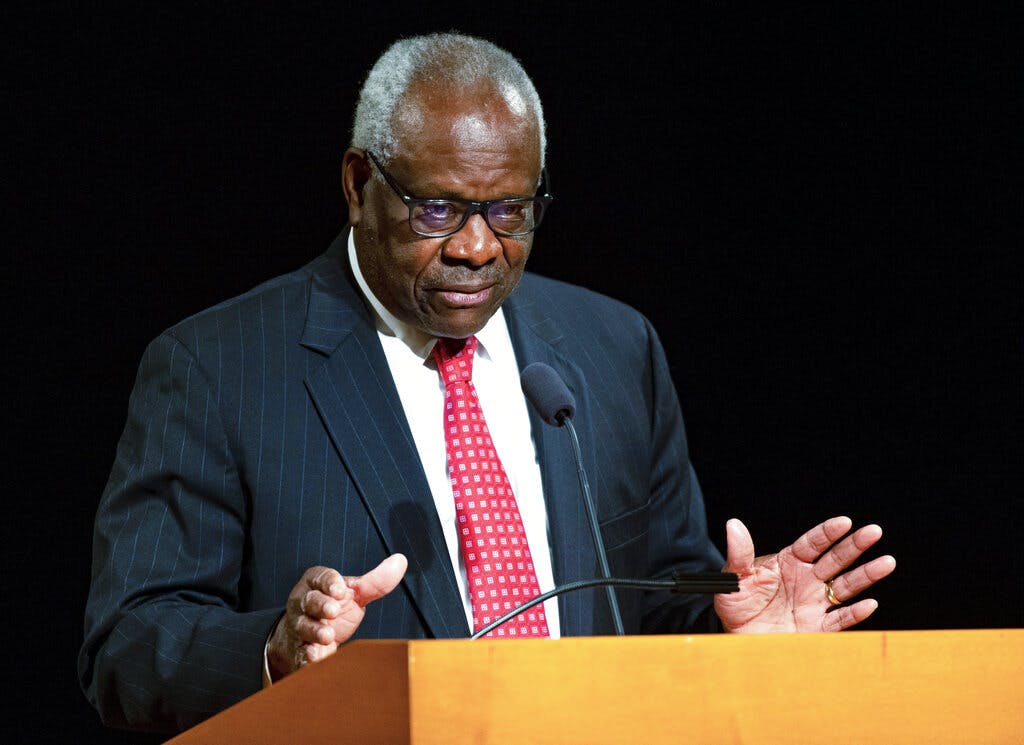Justice Thomas’ Duty
Democrats calling for Justice Thomas to recuse himself due to his wife’s activism all ignore the doctrine — one of the bedrock responsibilities of a United States judge — that Chief Justice Rehnquist called the ‘duty to sit.’

The demands that Justice Clarence Thomas recuse himself in cases involving the January 6 riot and, for that matter, the pending election are certainly coming fast and thick. Democrats are upset at text messages of his wife, Virginia, in favor of rejecting the electoral vote. They all ignore the doctrine — one of the bedrock responsibilities of a United States judge — that Chief Justice Rehnquist called the “duty to sit.”
That duty, as Rehnquist described it, isn’t, like much of law, absolute. It applies only when a judge is “not disqualified,” in the Chief Justice’s articulation. The Democrats are trying to palm off on our noble public the idea that Justice Thomas is disqualified because his wife, Virginia, is a political activist who was, among other things, egging on the idea that the electoral vote should have been rejected in Congress.
“The entire integrity of the court is on the line here,” Senator Klobuchar said Sunday, claiming that Mrs. Thomas’ messaging with President Trump’s chief of staff offers “a textbook case for removing him, recusing him from these decisions.” Ms. Klobuchar doesn’t cite which textbook she’s been consulting. So we checked our own favorite textbooks — our dog-eared copies of the Constitution and the United States Code.
It turns out that neither of these requires Justice Thomas to step aside. The United States Code does deal with recusal. It requires a judge to “disqualify himself” in any proceeding “in which his impartiality might reasonably be questioned,” but in 700 words of detail offers nothing that would require Justice Thomas to step aside because of his wife’s activities, perfervid though they might seem to those who disagree with her.
The law is strict on financial interests, but specifically ordains that an “office in an educational, religious, charitable, fraternal, or civic organization is not a ‘financial interest’ in securities held by the organization.” Chief Justice Roberts has noted that “the limits of Congress’s power to require recusal have never been tested” but that “individual Justices decide for themselves whether recusal is warranted” by the law.
That underscores his caution to preserve the independence of the judiciary “as a separate and coequal branch of government” and his interest in protecting the “courts from inappropriate political influence.” That latter point is, of course, at the heart of the campaign to strip Justice Thomas of his vote on the court. It’s possible to imagine the January 6 committee trying to drag in Mrs. Thomas simply to try to force her husband’s recusal.
On the other side is the duty to sit, which Chief Justice Rehnquist marked in a case involving a matter on which he’d once testified before Congress. He declined to recuse himself, pointing to circuit court rulings saying federal judges have “a duty to sit where not disqualified which is equally as strong as the duty to not sit where disqualified.” The “equal duty,” he added, “ is even stronger in the case of a Justice of the Supreme Court.”
That’s because, unlike the lower courts, there are no substitute Justices on the high court bench. Moreover, there “is no higher court of appeal which may review an equally divided decision of this Court.” As a result, a recusal can lead to “an affirmance of the judgment below by an equally divided Court.” If so, Chief Justice Rehnquist observed, “the principle of law presented by the case is left unsettled.”
While this was “obviously not a reason for refusing to disqualify oneself where in fact one deems himself disqualified,” Chief Justice Rehnquist saw it as “a reason for not ‘bending over backwards’ in order to deem one’s self disqualified.” Nor is Chief Justice Rehnquist the only justice to have marked this point. Justice Antonin Scalia later wrote: “Even one unnecessary recusal impairs the functioning of the Court.”
Chief Justice Roberts emphasized the Supreme Court’s unique role when he said the Constitution ordained “no higher court to review a Justice’s decision not to recuse in a particular case.” Nor, he adds, does the Supreme Court “sit in judgment of one of its own Members’ decision whether to recuse.” That, he reckons, could run the risk of the Nine affecting “the outcome of a case by selecting who among its Members may participate.”
For judges “contemplating recusal,” Chief Justice Roberts suggests the 1924 Canons of Judicial Ethics, drafted under Chief Justice Taft. The canons say that judges “should not be swayed by partisan demands, public clamor or considerations of personal popularity or notoriety,” and advise ignoring “unjust criticism.” Adds Chief Justice Roberts: “Such concerns have no role to play in deciding a question of recusal.” In other words, Justice Thomas has a duty to sit.

